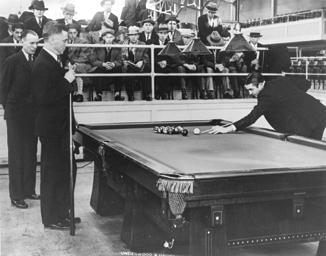|
|
Current Issue
Previous Page Page 5
Untold Stories: The Boy Wonder
 |
| By the time this photo was taken in 1928, Greenleaf had won more than a dozen titles. |
Soon afterwards Greenleaf appeared at a two-game exhibition in New York City. The venue was Maurice Daly's Academy. His opponent was George Clark, a well-respected player of the time. Greenleaf dispatched Clark with ease, even going so far as to administer a humiliating 52-and-out run in the second game. "He had perfect control of the cue ball, and invariably was in good position to make succeeding shots," reported The Times. According to the eyewitness account Greenleaf left himself almost no difficult shots and no combinations.
"Another feature was the perfection with which he played for his break shots when the 14 balls were racked up each time. He not only left the 15th ball so it could easily be pocketed, but so that he could break up the bunch as well. It was excellent generalmanship, and frequently caused spectators to applause." No longer erratic, Greenleaf now appeared to be mature and rock solid. He shot quick and he shot smart. He seemed to have put it all together. "Ralph Greenleaf stands an excellent chance of emerging with considerable prestige draped around his shoulders," The Times predicted. It would have been exciting to have been there, sitting in the tall chairs, watching it all unfold first hand.
The national title event got under way a couple of weeks later. Recall that Taberski, the most recent national champion, boycotted the competition because of the one-minute time limit. But all the rest were there, incluing Bennie Allen, Jimmy Maturo, Jerome Keogh, Edward Ralph, Johnny Layton and Charles Seeback. "It is quite an array of talent - in fact it compares favorably with any collection of cueists that has ever tried to scale the Pike's Peak of Pocket Billiards," wrote The Times. The round-robin event was held in Philadelphia on Dec. 1. There would be 45 matches in all.
Greenleaf won his first match in grand style, scoring nearly two points for every one for his opponent. Greenleaf's high run was 69. A week later Greenleaf plowed through Keogh, taking the match 125 to 54. "While many in the big crowd that witnessed the match expected Greenleaf to win, there were few who expected the margin of victory to be so decisive," The Times reported. Greenleaf won in 13 innings without a single scratch. Keogh scratched twice.
Greenleaf won his sixth straight on Dec. 11. At this point he seemed unstoppable. "He out-classed Maturo from the fourth frame to the finish," reported The Times. "The fact that Maturo is a former title holder made no more impression on Greenleaf than it did when he was pitted against Jerome Keogh." The final tally in that game was 123-63.
On Dec. 12 he decisively thrashed Edward I. Ralph. The score was 125-53. Greenleaf executed a run of 70 during that match - a run that The Times said "took all the heart out of Ralph and he missed shots after that which a tyro could have made with ease." The next day Greenleaf won again, but at this point it hardly mattered. With his victory the day before, Greenleaf had been proclaimed the youngest national champion in American history. His final record in the 1919 event was 9-0.
Ralph Greenleaf's stunning career was under way.
R.A. Dyer is the author of "The Hustler & The Champ," a biography of Minnesota Fats and Willie Mosconi. Find more pocket billiards history at Dyer's Untold Stories blog at www.poolhistory.com, or follow along on Twitter, @PoolHistoryBlog.
Previous Page Page 5
Top |
|





